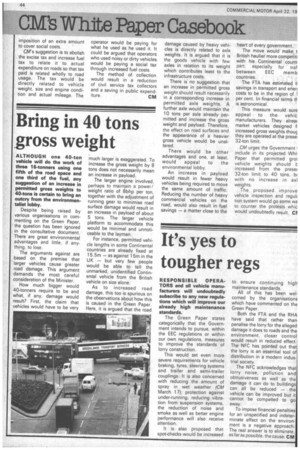Bring in 40 tons gross weight
Page 46

If you've noticed an error in this article please click here to report it so we can fix it.
ALTHOUGH one 40-ton vehicle will do the work of three 16-tonners using one fifth of the road space and one third of the fuel, any suggestion of an increase in permitted gross weights to 40-tons is certain to bring an outcry from the environmentalist lobby.
Despite being raised by various organisations in commenting on the Green Paper, the question has been ignored in the consultative document. There are great environmental advantages and little, if anything. to lose.
The arguments against are based on the premise that larger vehicles cause greater road damage. This argument demands the most careful consideration of the Minister.
How much bigger would 40-tonners require to be and what, if any, damage would result? First, the claim that vehicles would have to be very much larger is exaggerated. To increase the gross weight by 8 tons does not necessarily mean an increase in payload.
The larger engine involved, perhaps to maintain a power/ weight ratio of 8bhp per ton, together with the adjustment of running gear to minimise road surface damage would result in an increase in payload of about 5 tons. The larger vehicle platform to accommodate this would be minimal and unnoticeable to the layman.
For instance, permitted vehicle lengths in some Continental countries are already fixed at 15.5m — as against 15m in the UK — but very few people would be able to tell the unmarked, unidentified Continental vehicle from the British vehicle on size alone.
As to increased road damage, this too is spurious on the observations about how this is caused in the Green Paper. Here, it is argued that the road




















































































